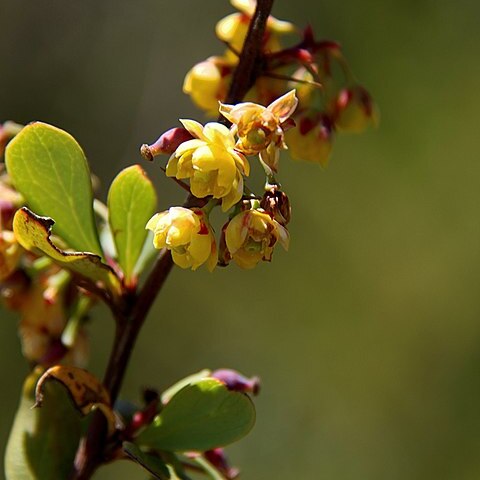Leaves usually clustered on short lateral shoots, almost sessile, apparently simple but in reality 3-foliolate with a normal, terminal leaflet articulated at its base and a petiole of c. 1 mm. long bearing 2 subulate lateral leaflets 1–3 mm. long at its apex. The petioles and subulate leaflets are characteristically persistent on the short shoots; lamina of terminal leaflet up to 6 x 2.7 cm., coriaceous, oblong or oblanceolate to obovate, midrib produced as a short prickle, margin prickly-dentate or more rarely entire, purplish when young and somewhat glaucous below.
A shrub. It grows 3 m high. It has spines divided into 3 parts. These can be 3 cm long. The leaves are in bunches and have 3 leaflets. They are very small. The flowers are yellow and several occur in a group. These groups can be 7 cm long. The fruit are red to blue-black. They are oval and 8-12 mm long by 6-7 mm wide. The seeds are 6 mm long by 3 mm wide.
Stamens on stout filaments c. 2 mm. long; anthers c. 2.5 mm. long, oblong, opening by a pair of spreading wing-like valves 1.5 mm. long, hinged at the apex of the anther-thecae.
Sepals increasing in size towards the interior, smallest c. 2 x 2 mm., largest c. 6.5 x 4 mm., ovate to broadly ovate, rounded at the apex.
Glabrous shrub up to 3 m. tall; branches purplish when young, sulcate, with 3-partite spines up to 4 cm. long.
Flowers yellow, in axillary racemes or cymes up to 5 cm. long; bracts c. 3 mm. long, lanceolate-acuminate.
Petals somewhat smaller than the inner sepals, obovate, with two linear glands near the base.
Berry c. 1.3 x 0.7 cm., ellipsoid, dark blue, pruinose, with a persistent stigma.
Ovary narrowly ellipsoid, c. 4-ovulate, with a broad capitate subsessile stigma.
Seed c. 6 x 3 mm., usually solitary, ellipsoid, brown, rugulose.

